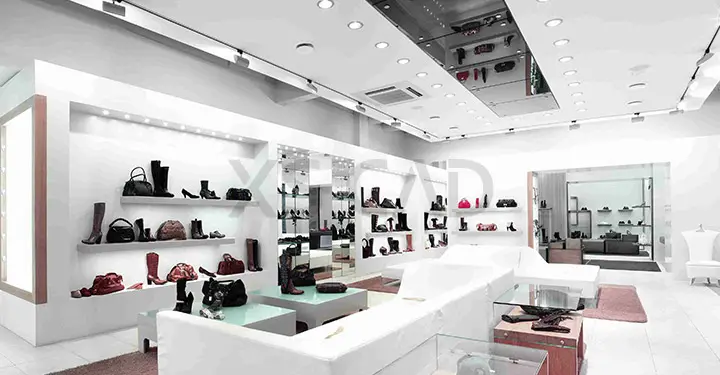Our Articles

Why 3D Benefits Retail Design
Retail drives our world today – our homes, what we have at home, where we work, how we get to work, what we wear and where and how we spend our leisure. The scope of retail design, therefore, is of paramount importance for retailers. Traditionally, retail design was managed in a 2D environment. A few years ago, the advent of 3D design improved the effects of retail design in a number of ways.
Primarily, retail spaces promote brands and increase sales. The customer must find the environment appealing enough for a repeat visit and conducive to buying products repeatedly. Retail design must incorporate company branding and marketing schemes while:
Mechanical and functional components can be part of the full details of any retail design using 2D drawings and 3D models. Knowing what the main features of 2D drawings and 3D models helps retail designers function effectively.
2D Drawing Features
3D Modelling
A 3D design will depict a retail space realistically and with depth, using accurate scale models for all fixtures and fittings, which can then also be used in images or animations. Using tools such as BIM means that retail designs, which usually feature a high level of repeatability, are easier to schedule and therefore apply a cost measurement.
The art of producing 3D images depicting the architectural design of a space is called rendering, which can be used to evaluate, analyse and change proportions and scales, simulating lighting, colour schemes, textures, internal furnishings and brand images.
The use of 3D in retail design helps designers, customers and other stakeholders communicate seamlessly and collaborate easily. Designers can work on designs in real time, while looking at different options, editing and sharing their thoughts using efficient 3D software, such as Revit. Reliable and versatile modelling and rendering software include SketchUp, Rhino, VRay, Maxwell, Mental Ray and AutoCAD. Designers can get a clear understanding of the nature of the retail spaces being designed. The rendered 3D retail images can be used effectively as a marketing tool, for planning and to improve designs.
Though some projects require hand-drawn or 2D drawings, retail BIM modelling is a more complete package to present a clear understanding of the project idea. Many changes and improvements to design are realised and implemented when viewing 3D images.
Comparing 2D and 3D Design
Software:
Generally, 2D CAD is useful to draft plans, sections and elevations. Using 3D design processes, the designer can model objects and produce a variety of retail design views by rotating the model in 3D. Two-dimensional drawings can be developed from the 3D images.
Hardware:
Virtually all computers are able to use 2D CAD software.
Several 3D CAD programmes require a high-performance computer.
Functionality:
When only the basic functions are required, many find that 2D CAD is all they need.
A designer can use functions such as 3D arrays, reference views and many more in 3D programmes.
Rendering:
Rendering is not possible with 2D CAD software. Views must be exported to a separate programme for rendering.
A majority of 3D programmes can render photorealistic images.
Cost:
Since it is more advanced, 3D CAD is much more expensive than 2D CAD solutions.
The benefits of using 3D visualisation over 2D CAD seems to open the design process to greater efficiency and improved aesthetics. Retail designs can expand and innovate. Experience has shown that 3D design results in time, cost and material savings. Processes and the quality of retail design is improved with 3D design, and retail designers can be more creative and accurate.
Why Moving to 3D Design is Beneficial
Fast Approvals:
The clear and detailed depiction of retail design in a 3D view fosters quick understanding of the design concept and its overall final view, speeding up the time taken for approvals.
Quick, Easy Design Changes:
Working in a 3D environment makes changes easy and quick, reducing the chance for errors and making the process faster.
Animations, Renderings:
Customers, managers and partners can view how a design concept functions using renderings or animation through 3D visualisation. Catalogues and other realistic images of multiple views can help the sales and marketing teams.
Analysis:
Using 3D visualisation, designers can analyse a design or modify it to improve performance, save material and save costs.
Attractive Proposals:
In the case of RFQs (request for quotations), 3D images and animations are full of useful information. Increasingly, companies prefer considering proposals in 3D.
Manufacturing:
Designing in 3D means that a design is ready to be taken directly to manufacturing.
The move to detailed retail design is projected to be a move to greater success, which ultimately favours retail BIM modelling over using only retail design drawings. Pluses include faster design approval, greater innovation, attractive sales and marketing material, appealing proposals, faster development of manufacturing designs and detailed analysis that will ultimately save material, time and costs. Retail giants have experienced significant returns on investment (ROIs) after moving to 3D design, improving the efficiency and aesthetic appeal of retail spaces while promoting the brand image.

